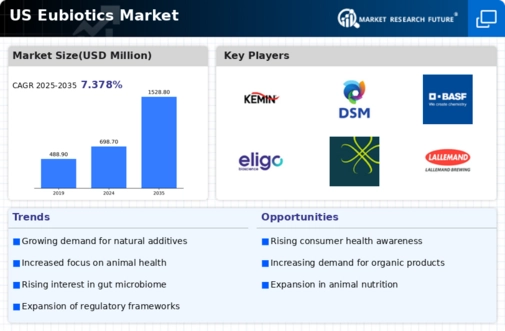The US Eubiotics Market has witnessed substantial growth in recent years, driven by increasing consumer awareness regarding health and wellness, alongside rising demand for natural and organic products. Companies operating in this sector are turning towards innovative solutions that promote a healthy gut microbiome, both in humans and animals. The competitive landscape is characterized by a combination of established firms and emerging players, each striving to differentiate their offerings through product development, strategic partnerships, and effective marketing strategies. The market dynamics are further shaped by regulatory frameworks and consumer preferences that increasingly favor sustainable and environmentally friendly alternatives.
With technological advancements and research-driven approaches, businesses are seeking novel ways to enhance their position within the eubiotics domain.Kemin Industries has established itself as a significant player in the US Eubiotics Market, leveraging its extensive research and development capabilities to produce high-quality products. The company has a robust portfolio of eubiotics solutions that cater to both animal health and human gut health. Their commitment to sustainability and quality is evident in their sourcing and manufacturing processes. Kemin Industries has built a strong brand reputation based on innovation and reliability, positioning itself to meet the diverse needs of its customers.
The company's well-established distribution networks allow for widespread market presence, facilitating the efficient delivery of its products to various segments within the eubiotics sphere. The synergy between scientific research and practical applications in their offerings underlines Kemin's competitive advantage in the US market.Royal DSM boasts a formidable presence in the US Eubiotics Market, with a well-rounded suite of products aimed at improving gut health and optimizing overall well-being. The company is known for its specialty ingredients that cater to both the animal nutrition and human nutrition sectors.
Royal DSM focuses on innovation and sustainability, further solidified through strategic mergers and acquisitions that expand its market reach and product offerings. Their commitment to research collaboration and product development enables them to effectively respond to emerging trends and consumer demands, positioning the company as a leader in the eubiotics space. Key products include probiotics, prebiotics, and other functional ingredients aimed at enhancing health outcomes. Royal DSM's strong emphasis on quality and effectiveness, coupled with comprehensive market presence, underscores its strengths in the competitive landscape of the US Eubiotics Market.
























Leave a Comment